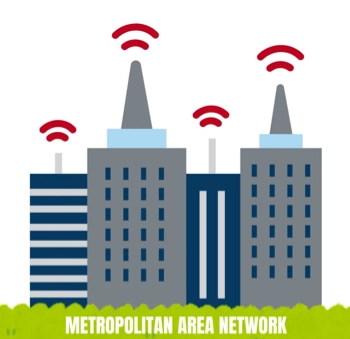What Is a Metropolitan Area Network (MAN)?
Computer networks are systems that allow computers to communicate with each other by sharing data and resources. These networks are essential for Internet users to stay connected. Various types of networks, from local area networks to metropolitan area networks, are based on size and the area they cover.
Local area networks (LANs) connect devices within a small area. Wide area networks (WANs), on the other hand, cover large regions; the Internet itself is an example of a WAN. But what about the areas in between these two networks? A metropolitan area network, or MAN, is the intermediary. In this article, learn what a metropolitan area network is, how it works, and how it differs from other networks.
What is a metropolitan area network (MAN)?
A MAN (metropolitan area network) is a network that spans a metropolitan area, like a city or multiple cities. It connects computers and networks across various locations, covering an area larger than a local area network but smaller than a wide area network.

LANs connect computers in a single building. A MAN network connects these different LANs over a broader area. It could link various organizations, schools, or businesses within a city. Therefore, this network type is an ideal solution for managing communication between facilities spread over a large area.
The idea of metropolitan area networks came about when businesses needed to connect their internal LANs. However, they couldn't rely on the public telephone network, which was not designed to handle high data traffic volumes.
In 1994, linking LANs through single-mode optical fiber lines became possible, paving the way for the development of MANs. This allowed for efficient data transfer between locations within cities.
MANs use fiber optic cables to provide high-speed, reliable connections. Unlike WANs, which often rely on public infrastructure, MANs are usually private networks managed by companies or institutions.
How does a MAN work?
A MAN connects different local area networks (LANs) across a region. It uses fiber optic cables to transmit data at very fast speeds over long distances. These cables are more reliable than regular copper wires because they can handle the heavy data traffic of an extensive network.
In a MAN, several LANs are connected using networking devices like switches and routers. Switches help direct data between different parts of the network. Routers then decide the best path for the data to travel. These devices ensure that information moves smoothly between locations without bottlenecks.
The backbone network is the core component of the MAN, carrying most of the data. The backbone consists of high-capacity cables that provide fast and reliable communication between different LANs.
In many instances, cities or universities lease their unused fiber optic cables, known as "dark fiber," to private companies. Leasing dark fiber is a cost-effective way for organizations to establish a MAN without laying down their own cables.
MANs can also connect to larger networks like wide area networks. The MAN acts as a middle layer, connecting smaller LANs within the city to the WAN. This setup enables organizations to have internal communication across their locations.
Metropolitan area network characteristics
A metropolitan area network, or MAN, is most identifiable by its ability to link several local area networks across a large area, allowing different locations to communicate and share resources efficiently. These networks cover anywhere between five and fifty kilometers. They can easily support large organizations, connecting multiple buildings or campuses within a metropolitan area.
Various network topologies, like ring, mesh, or star, provide the structure of a MAN. Each topology is selected based on the need for reliability in managing data flow. With moderate to high data speeds, MANs support fast communication between connected networks.
A MAN is generally owned and managed by a user group or a service provider who has full control over the network. By connecting multiple locations, MANs then allow the sharing of critical resources like printers, servers, and data storage and bridge the gap between smaller LANs and larger networks like WANs. This integration enhances external connectivity while maintaining a robust internal network for local data exchange.
Components of MAN
In identifying a metropolitan area network, look for the following key features.
- Fiber-optic cables. The networks use fiber-optic cables to share data. These cables are made of thin glass fibers. They offer high-speed Internet, which is important for connecting large city areas.
- Routing devices. Routers and switches are like traffic controllers for the Internet. They help direct data to the right places in a MAN. These devices make sure computing devices can talk to each other within the network.
- Wireless connectivity. Sometimes, MANs use wireless technology, like WiFi, to connect areas where cables can't be easily placed. As a user, you can extend Internet access to more places without installing more wires.
Many organizations rely on metropolitan area networks, meaning these components are all essential to provide function and Internet access to the people and entities that need a MAN.
Comparing networks: LAN vs. MAN vs. WAN
| Feature | Local area network (LAN) | Metropolitan area network (MAN) | Wide area network (WAN) |
| Geographical range | Covers a small area like a building (up to 1 km) | Covers a city or metropolitan area (5-50 km) | Covers a large geographical area (across cities, countries, or globally) |
| Speed | High speed | Moderate to high speed | Varies depending on distance, usually slower than LAN and MAN |
| Cost | Low cost | Moderate to high cost | High cost |
| Use case | Used within a single building or campus | Used to connect multiple LANs across a city | Used to connect LANs over large distances |
| Ownership | Usually owned by a single organization | Typically owned by municipalities, service providers, or large organizations | Typically owned by multiple organizations, governments, or ISPs |
| Technology used | Ethernet cables, WiFi | Fiber optic cables, hybrid topologies | Satellite links, leased lines, undersea cables |
Benefits of using a MAN
When used for the right purpose, a metropolitan area network provides many benefits to the organization or groups using it. Consider the following benefits:
- Improved communication and connectivity. A MAN connects different LANs to provide reliable communication between multiple locations. Whether it's between offices, campuses, or municipal institutions, users can access shared resources seamlessly.
- Increased reliability and scalability. A MAN offers higher reliability than a WAN due to its use of dedicated fiber optic lines. As a network grows, a MAN can be expanded by adding new connections or networks. It provides a scalable option for businesses looking to grow their operations.
- Enhanced security features. Since MANs are often private networks, they are more secure than WANs. Many of these networks can include advanced security measures, like firewalls, encryption, and network monitoring, to protect sensitive data as it travels between locations.
Applications of metropolitan area networks
Large businesses with multiple offices in different parts of a city often use MANs to connect their networks. In this sense, employees communicate more efficiently. It also helps businesses reduce the costs of using multiple WANs or public networks.
Learning institutions also rely on MANs to link their campuses. Both students and staff access shared servers, databases, and online resources from different locations. Research institutions do benefit from the high-speed data transfer capabilities of MANs when conducting large-scale projects.
Municipal governments use MANs to connect offices, fire stations, police stations, and public services across a city. This improves response times because data is shared quickly between different departments.
Limitations of MANs
While they offer many benefits to those who use them, metropolitan area networks aren't flawless. They have certain limitations that restrict their flexibility and service.
One of the biggest challenges in setting up a MAN is the cost of installing fiber optic cables. Laying these cables across a large city can be expensive if the area has many physical obstacles, like buildings. Maintaining these networks also requires technical expertise, adding to the overall cost.
While MANs can save money in the long run by reducing the need for multiple WAN connections, the initial investment in infrastructure is high. Organizations must consider the cost of installation, maintenance, and equipment when setting up a MAN.
Although MANs are generally more secure than WANs, they are still vulnerable to security threats. Hackers may target the fiber optic cables or network devices to access sensitive data.
Any organizations using MANs must implement strong security measures, including encryption and network monitoring, to protect their data.
Examples of metropolitan area networks
Whether you know it or not, you've encountered metropolitan area networks before in your day-to-day life. The following are all examples of MANs, from the telephones in your home to the technology standards on the Internet you access.
- Cable TV network. A cable TV network connects homes in a city to provide television channels. It uses cables to deliver TV signals. The network works over a wide area.
- Telephone networks. Telephone networks connect people across large cities. The network allows people to make calls over long distances using wires and other technology.
- DSL line. DSL lines provide Internet access through telephone wires. They let homes and businesses in a city connect to the Internet.
- The IUB network. The Indiana University Bloomington (IUB) network connects students, staff, and buildings across the campus. It uses both wired and wireless technologies. This wide-reaching network is a real-world example of a MAN.
- IEEE 802.16. IEEE 802.16 is a technology standard for connecting large areas to the Internet. It provides wireless broadband service over long distances.
- WiMAX. WiMAX is a wireless technology that provides fast Internet over large areas. It can cover entire cities or regions. WiMAX helps create MANs by offering wireless connections where cables are unavailable.
Future trends in metropolitan area networks
The integration of 5G technology into MANs will significantly improve network performance. 5G offers faster data speeds, meaning information can instantly be transferred. This advancement will benefit many applications, such as real-time video streaming, virtual reality, and large data transfers. With 5G, MANs will support more devices.
Metropolitan area networks are also crucial for the development of smart cities. Smart cities leverage advanced technologies to improve urban living. Fortunately, MANs provide the infrastructure to support these systems.
For example, Internet of Things (IoT) devices, such as smart sensors, require fast and reliable networks to function correctly. MANs connect devices across a city to support smart grids and intelligent transportation systems.
Smart grids manage energy distribution efficiently. Intelligent transportation systems use real-time data to monitor and control traffic. It’s anticipated that cities will respond faster to residents' needs.
Frequently asked questions
What is the typical range of a MAN?
A computer metropolitan area network generally covers distances of 5 to 50 kilometers.
What technologies are used in metropolitan area networks?
MANs can use technologies such as fiber optics, Ethernet, wireless connections, and MPLS for efficient data transmission.
How fast is a MAN compared to other networks?
MANs can offer speeds ranging from 100 Mbps to 10 Gbps or even higher. For example, Ethernet-based MANs deliver speeds of 100 Mbps to 1 Gbps. Fiber optic-based MANs can support speeds from 1 Gbps to 10 Gbps.

